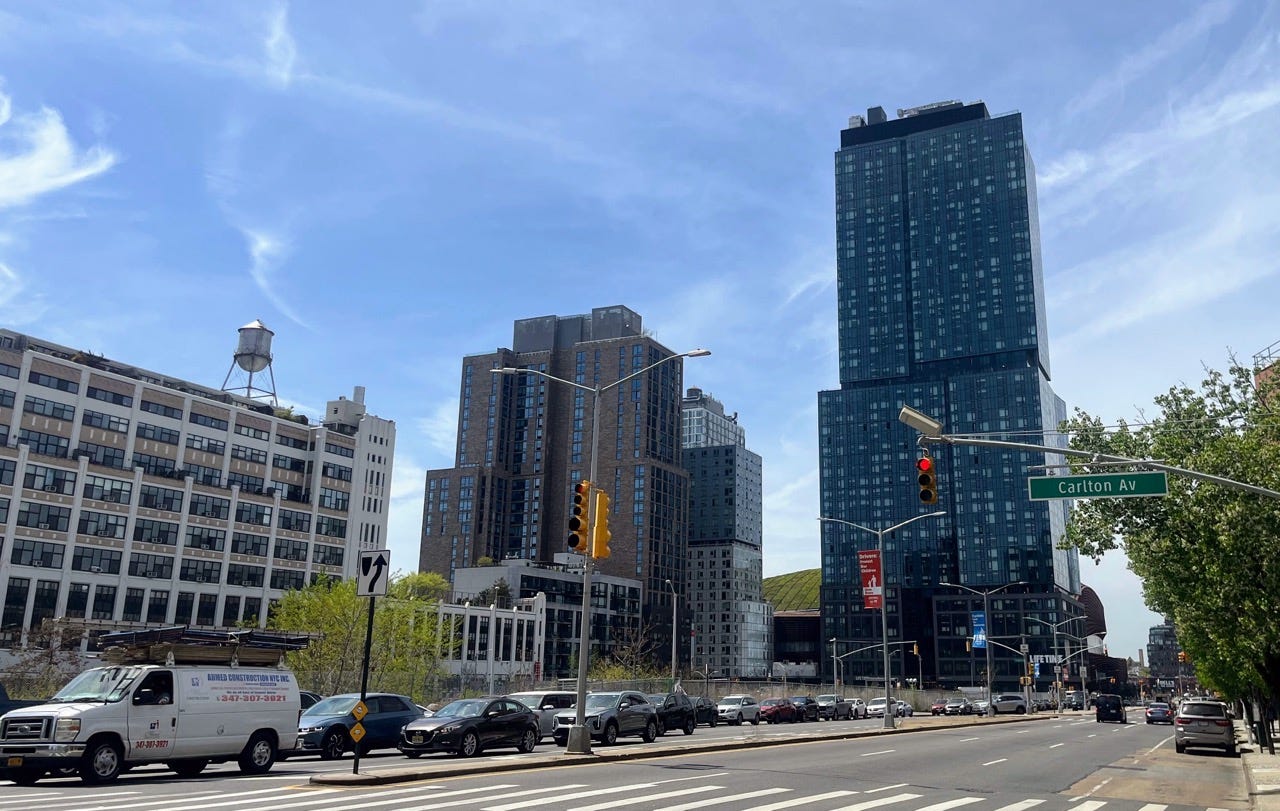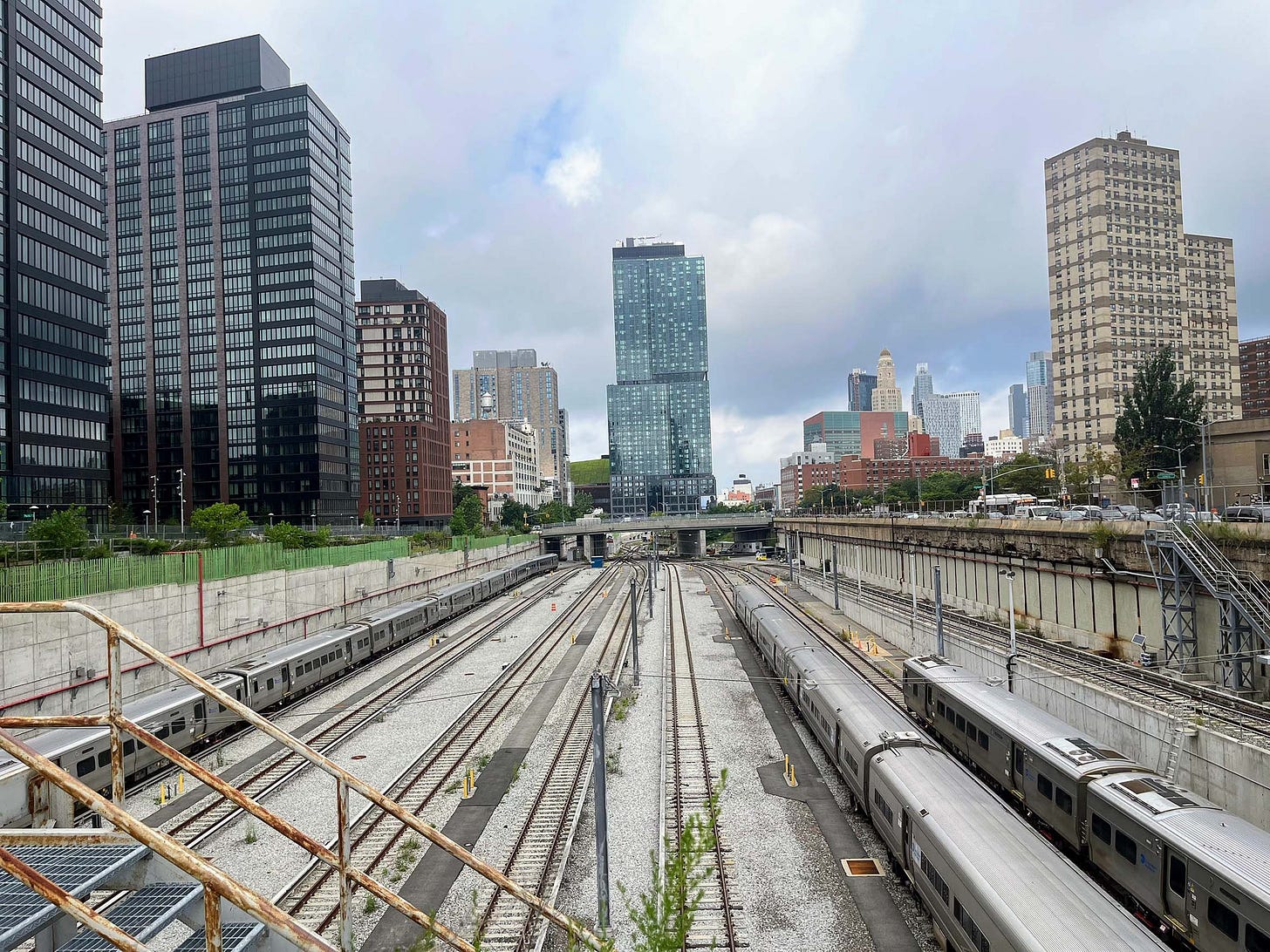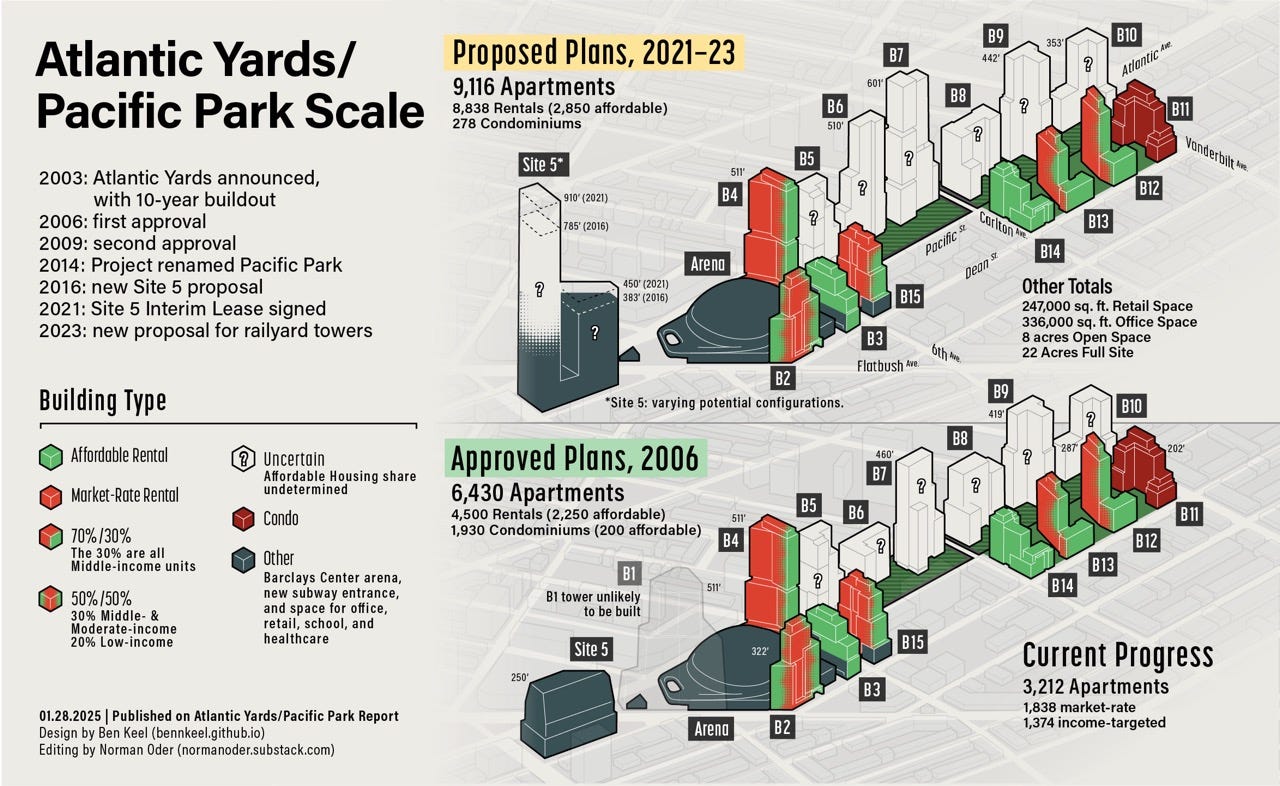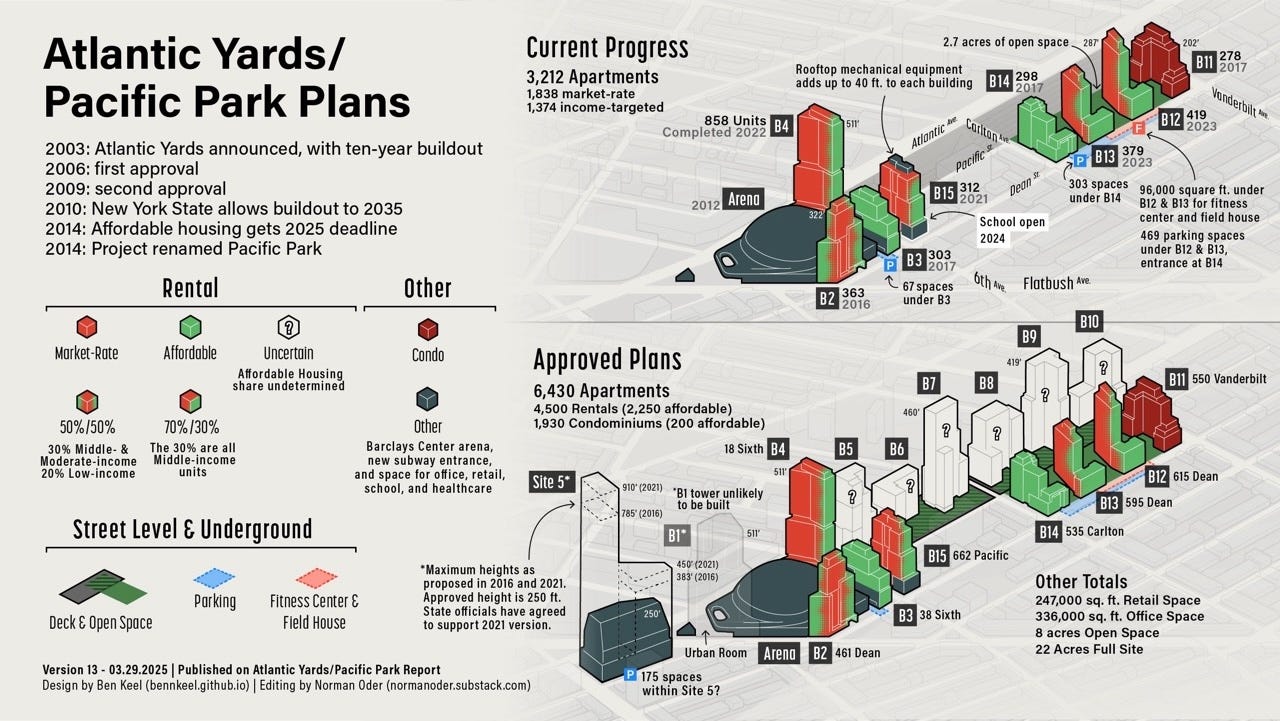Emerging Developer Cirrus Seeks Tax Abatement, New Funding, & (More?) Entitlements for Railyard Sites
When will details of request for concessions emerge? What public benefits? Lobby report cites Empire State Development, local elected officials, and even Attorney General James.
It looks like Cirrus Workforce Housing Advisors, the new firm with support from unions for a new joint venture to develop six Atlantic Yards/Pacific Park railyard sites now facing foreclosure, is charging ahead.
(Also, it likely has support from mayoral candidates Andrew Cuomo and Eric Adams.)
In Cirrus's first-ever lobbying report, filed with New York State's Commission on Ethics and Lobbying in Government and covering March-April 2025, the company discloses that it is not simply aiming to take over the development sites (B5-B10) from master developer Greenland USA under current parameters.
Rather, as the joint venture seeks to acquire those sites through foreclosure, it likely aims to sweeten the deal to build six large towers, which require an expensive platform over the Metropolitan Transportation Authority’s (MTA) Vanderbilt Yard, used to store and service Long Island Rail Road trains.
Cirrus discloses that its lobbying subjects include:
A tax abatement
State funding
State entitlements
The details on those are unclear and my queries yesterday didn’t turn up much. So I have to speculate, as described below.
But any concessions by the state, I’d contend, should 1) trigger reciprocal public benefits and 2) not overwhelm project neighbors.
In response to my query yesterday, Assemblymember Jo Anne Simon, one of those lobbied, said she knew “very little about details” and, because it was Dyslexia Advocacy Day (a key focus for her), she had no time to discuss it.
Deadline pending
Keep in mind that Greenland, nominally the master developer for now, faces a May 31 deadline to deliver 876 more (of 2,250 required) affordable units. That deadline won’t be met.
Its failure to repay about $286 million in low-interest loans from immigrant investors under the EB-5 investor visa program means that the collateral for those loans, the rights to those six development sites, has been facing foreclosure since late 2023.

However, the foreclosure can’t go forward until Empire State Development (ESD), the state authority that oversees/shepherds the project, approves a “permitted developer” to take over those sites. However, no developer would step forward without starting to negotiate with ESD over the project’s future parameters, since that shapes the bottom line.
So, will ESD pursue the $2,000/month damages for each missing unit seemingly required by the June 2014 settlement with the coalition BrooklynSpeaks that set the new deadline? For now, those damages would be pursued against Greenland, which, given postponements of foreclosure, remains the railyard sites’ zombie developer.
At a March 25 meeting of the advisory Atlantic Yards Community Development Corporation, ESD’s Joel Kolkmann, Senior VP, Real Estate and Planning, invoked a question posed at a February oversight hearing to ESD CEO Hope Knight by Assemblymember Simon.
Knight’s response, he said, holds true: “absent us receiving a permitted developer package and proposal and a plan prior to that date, we obviously would have to move forward with pursuing liquidated damages.” (I thought Knight seemed less than enthusiastic.)
“If we were to receive something in the very near term,” Kolkmann told the advisory board, ESD would consider a delay on the liquidated damages, “with very clear milestones of what would have to happen in the very near term."
That might be the emerging path.
Who’s involved?
Cirrus Workforce Housing Advisors is led by the new firm Cirrus Real Estate Partners, but also involves the Building and Construction Trades Council of Greater New York and Vicinity, which last year formed a partnership with Cirrus to build workforce housing, announced by Mayor Adams. Both union pension funds and Cirrus would contribute funding.
The Cirrus joint venture for Atlantic Yards presumably also involves Fortress Investment Group and affiliates of the U.S. Immigration Fund (USIF), the company that recruited EB-5 investors.
With some $286 million of that loan in default, the creditors--a complex and unclear mix, but with USIF seemingly at the helm--can't foreclose on the collateral before Empire State Development (ESD) approves an entity as a permitted developer.

ESD, the state authority that oversees/shepherds the project, defines a permitted developer as having at least a decade of experience in large-scale projects or retaining a construction manager with such experience.
No one in the Cirrus deal would qualify, though they could hire a construction manager. ESD also allows for “a Person that is reasonably acceptable to Landlord,” which offers more slack.
However, offering slack to less-than-experienced entities has proven perilous in the history of Atlantic Yards, given the Greenland example. Heck, offering slack to original developer Forest City Ratner, which did have experience, didn’t go well, either.
Given the role of the U.S. Immigration Fund, which marketed the EB-5 loans with dubious promises, allegedly misled original investors, and has since clearly misled investors, why should any deal with their involvement be trusted?
The tax abatement
Could the tax abatement be something beyond the current 485-x abatement, which succeeded the more lucrative 421-a tax break and requires deeper affordability (while extending the tax benefit)?
Keep in mind that Related Companies, when it was exploring a potential joint venture with the USIF and Fortress, explored the possibility of restoring the expired 421-a tax break for Atlantic Yards/Pacific Park.
(Remember, it’s about the numbers: “Form follows finance,” to quote one of my Atlantic Yards/Pacific Park mantras.)
That's not out of the question. ESD was able to bring back a synthetic version of 421-a to enable the Gowanus rezoning to proceed.
Land use funding
What might "funding" refer to? Keep in mind that, along with various tax breaks, the power of eminent domain, and an override of city zoning, New York State contributed $100 million in direct funding.
New York City contributed $205 million (or maybe $185 million), and has since offered tax-exempt bonds and other housing assistance.
Could Cirrus be seeking state help to build the costly platform, the deck over the two-block railyard, which would cost hundreds of millions of dollars and, presumably, was calculated into the previous overall development budget, given the enormous amount of buildable square footage?

Or: might it seek state funding for some public amenity that would be part of the project? (“Help us accelerate the open space!” “Help us build the promised intergenerational center!”)
Or: does this involve state housing subsidies? (I would be less surprised at the pursuit of city housing subsidies, though Cirrus hasn’t yet reported lobbying city officials, as Related had done.)
Land use entitlements
As to "land use entitlements," that could cover a lot of ground. I doubt it simply means: "let us take over from the current developer.”
It's more likely that Cirrus is seeking increased square footage--free land!--to make the project more economically viable, just as Greenland USA sought in 2023. (See my coverage.)

Keep in mind that development rights, controlled by the Metropolitan Transportation Authority, were put out for bid in 2005, not given away.
Greenland's effort in 2023 suggests an effort to gain free development rights, while promising a greater number—albeit at a slower pace—of below-market "affordable" units. I wouldn’t be surprised if that recurs.
In 2023, Greenland also sought to claim more open space. The developer suggested that ESD work with the New York City Department of Transportation “to explore using additional portions of Pacific Street, between Sixth and Carlton avenues, as Open Space.”
That might help keep the ratio of “Pacific Park” space to the growing population. But it also would be free land.
The ESG connection
Cirrus in September 2023 was part of a Pension Summit on Environmental, Social, and Governance (ESG) investing, held by the Long Island Labor Advisory Council, aiming to give the labor movement solid investment returns and also advance their causes.

The Cirrus introduction notes:
The cost of housing is now the most important item facing the middle class and all of Labor…. HOUSING. Policy makers are now seeking Public Private Partnerships to solve for this growing social problem. This is evidenced by Governors in Massachusetts, New Jersey and New York all making affordable housing a top agenda item. States are now adding more incentives and public investment to entice development. Affordable and Workforce housing are a core component in ESG investing as more institutions are investing in Social Housing to solve for the S in ESG.
That ESG designation adds a halo that attracts some institutional investors. However, sometimes pursuit of ESG credit—for example, putting a beehive on the roof of a residential building, as with 38 Sixth Avenue—can backfire.
Who was lobbied?
It's unsurprising that Cirrus lobbied five people working at Empire State Development. They're the ones negotiating the deal.
It's not surprising that they've met with Assemblymember Simon, who represents one parcel (Site 5; part of separate negotiations) in the project footprint and, as a supporter of BrooklynSpeaks, has long been involved in project advocacy.
It’s not surprising that they met state Sen. Jabari Brisport, since he represents the full project site.1
However, it is surprising they haven't (yet) reported meetings with other local elected officials, notably Assemblymember Robert Carroll, who represents the railyard blocks, or Assemblymember Phara Souffrant Forrest, whose district includes the north flank of Atlantic Avenue opposite the railyard.
I queried Carroll yesterday, but didn’t hear back.
It's a little surprising they met with New York State Comptroller Thomas DiNapoli, though it's possible that the Comptroller has to sign off on some financial issue.
What about Tish James?
It's curious that Cirrus has lobbied the Office of Attorney General Letitia James, apparently meeting with James herself. (Or maybe it’s not. Related met with James, too.)
Do they need the Attorney General’s sign-off? Do they want James—a noted opponent of Forest City Ratner’s Atlantic Yards plan while the Council Member from the 35th District—to support project changes or, at least, remain neutral?
Are they playing the long game, making nice with the Democrat best positioned to succeed Gov. Kathy Hochul, either in 2030 or earlier? After all, Atlantic Yards/Pacific Park (under, perhaps, a new name) could take another 12 to 15 years, maybe longer.
It’s worth noting that, introducing a screening in Feb. 28 of the documentary Battle for Brooklyn, which chronicled the Atlantic Yards opposition, James, a featured player in the film, made an offhand reference to emerging project changes.
At Pioneer Works in Red Hook (go to 17:03 in the video below, or click here), James mentioned a "new construction firm" emerging to build over the railyard and said "we've got to come together to make sure that they build it right.”
So, had James been briefed even before the March-April period? Cirrus on Feb. 21 filed a registration indicating it would start lobbying on March 1.2
I queried James yesterday about the lobbying and got a general response from her office. Asked if she knew anything about the project’s potential parameters, the response—not fully direct—was that she was not privy to meetings between ESD and Cirrus.
As a lifelong Brooklynite and community member, James remains interested in the project’s future, I was told, believes that any major development project in the state should be done with community input and collaboration.
That’s hardly controversial, but in this case the community input typically comes after the deal is baked.
As to whether James had already been informed in February, well, I didn’t get an answer. But any statewide elected official surely intersects with organized labor.
Who’s missing?
It's also surprising that Cirrus does not report meetings with the Metropolitan Transportation Authority, as Related did. Maybe that's upcoming.
Perhaps some of the groundwork has proceeded, but presumably any joint venture would have to reach an agreement with the MTA to begin the platform.
It's also surprising that Cirrus has not yet reported lobbying the Governor's office. After all, Hochul is the ultimate decision-maker. Or maybe ESD has gotten clear instructions from their boss.
State Sen. Andrew Gounardes’ district stretches from Bay Ridge to wrap around the north side of Atlantic Avenue, past Sixth Avenue to border the B5 site and maybe even B6.
Those lobbying on behalf of Cirrus Workforce Housing Advisors LP include executives Joseph McDonnell, Anthony Tufariello, and Kevin Gallagher, a former Director of Housing for the New York City Central Labor Council, as well as Associate Thomas Brady. Also lobbying for them is Stephen McInnis. Political Director at NYC District Council of Carpenters.





